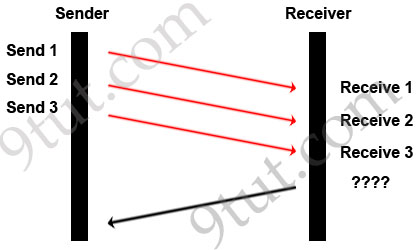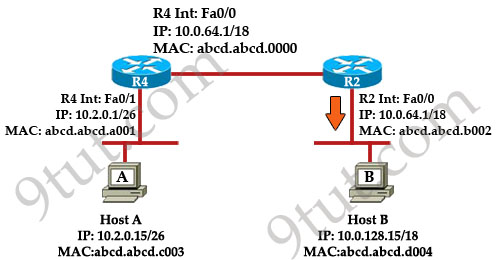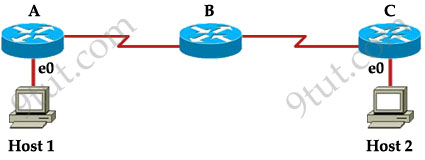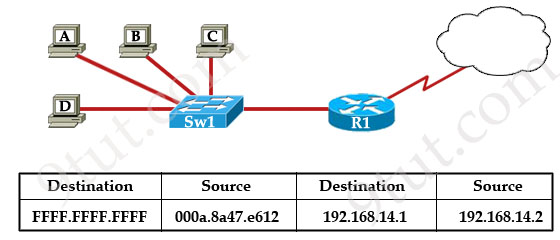CCNA – TCP/IP Model & Operation
Here you will find answers to TCP/IP Model & Operation Questions
Question 1
An inbound access list has been configured on a serial interface to deny packet entry for TCP and UDP ports 21, 23 and 25. What types of packets will be permitted by this ACL? (Choose three)
A. FTP
B. Telnet
C. SMTP
D. DNS
E. HTTP
F. POP3
Answer: D E F
Explanation
The access list denies packet entry for TCP & UDP -> all the services on ports 21, 23 and 25 are disabled. Services on these ports are FTP (port 21), Telnet (port 23), SMTP (port 25). Other services are allowed so D E F are the correct answers.
Question 2
What are two characteristics of Telnet? (Choose two)
A. It sends data in clear text format.
B. It is no longer supported on Cisco network devices.
C. It is more secure than SSH.
D. It requires an enterprise license in order to be implemented.
E. It requires that the destination device be configured to support Telnet connections.
Answer: A E
Explanation
Telnet, part of the TCP/IP protocol suite, is a virtual terminal protocol that allows you to make connections to remote devices, gather information, and run programs. Telnet is considered insecure because it transfers all data in clear text -> A is correct.
The destination device needs to support Telnet connection. For example, if a device doesn’t support TCP/IP protocol suit then maybe we can’t telnet to it.
Question 3
An administrator issues the command ping 127.0.0.1 from the command line prompt on a PC. If a reply is received, what does this confirm?
A. The PC has connectivity with a local host.
B. The PC has connectivity with a Layer 3 device.
C. The PC has a default gateway correctly configured
D. The PC has connectivity up to Layer 5 of the OSI model
E. The PC has the TCP/IP protocol stack correctly installed.
Answer: E
Explanation
The address 127.0.0.1 is called loopback address. When we ping 127.0.0.1, in fact we are testing if the TCP/IP protocol suite is installed on our device.
Note: The address 127.0.0.1 does not have anything related with the NIC card. We still ping 127.0.0.1 even if we don’t have the NIC card.
Question 4
Where does routing occur within the DoD TCP/IP reference model?
A. application
B. internet
C. network
D. transport
Answer: B
Explanation
The picture below shows the comparison between TCP/IP model & OSI model. Notice that the Internet Layer of TCP/IP is equivalent to the Network Layer which is responsible for routing decision.

Question 5
A host is attempting to send data to another host on a different network. What is the first action that the sending host will take?
A. Drop the data.
B. Send the data frames to the default gateway.
C. Create an ARP request to get a MAC address for the receiving host.
D. Send a TCP SYN and wait for the SYN ACK with the IP address of the receiving host.
Answer: B
Explanation
Before sending data, the sending host checks if the destination host is inside or outside the local network. If it is outside the local network, the data will be sent to the default gateway.
Question 6
A TCP/IP Transfer is diagrammed in the exhibit.
A window size of three has been negotiated for this transfer. Which message will be returned from the receiver to the sender as part of this TCP/IP transfer?

A. Send ACK 1-3
B. Send ACK 3
C. Send ACK 4
D. Send ACK 4-6
E. Send ACK 6
F. Send ACK 7
Answer: C
Explanation
In response, the receiver replies with an ACK. The acknowledgment number is set to one more than the received sequence number. The ACK means “I have got all messages up to sequence number n-1 so please send me the message for sequence number n”.
Question 7
What is the purpose using the traceroute command?
A. to map all the devices on a network.
B. to display the current TCP/IP configuration values.
C. to see how a device MAC address is mapped to its IP address.
D. to see the path a packet will take when traveling to a specified destination.
E. to display the MTU values for each router in a specified network path from source to a destination.
Answer: D
Question 8
A network admin wants to know every hop the packets take when he accesses cisco.com. Which command is the most appropriate to use?
A. path cisco.com
B. debugcisco.com
C. trace cisco.com
D. traceroute cisco.com
Answer: D
Question 9
Refer to the exhibit. Host A pings Host B. What source MAC address and source IP address are contained in the frame as the frame leaves R2 destined for host B?

A. abcd.abcd.a001
B. abcd.abcd.b002
C. abcd.abcd.c003
D. 10.2.0.15
E. 10.0.64.1
F. 10.0.128.15
Answer: B D
Explanation
When packets are sent from Host A to Host B, the source and destination IP addresses are never changed and they are the IP addresses of Host A & Host B. Only the MAC addresses will be changed to reflect the device of the current network. In this case, when the frame leaves R2 destined for host B. It will have:
+ Source IP: IP of Host A - 10.2.0.15 (never changed)
+ Destination IP: IP of Host B – 10.0.128.15 (never changed)
+ Source MAC: MAC of Fa0/0 of R2 – abcd.abcd.b002
+ Destination MAC: MAC of Host B – abcd.abcd.d004
Question 10
Host 1 is trying to communicate with Host 2. The e0 interface on Router C is down. Which of the following are true? (Choose two)

A. Router C will use ICMP to inform Host 1 that Host 2 cannot be reached.
B. Router C will use ICMP to inform Router B that Host 2 cannot be reached.
C. Router C will use ICMP to inform Host 1, Router A, and Router B that Host 2 cannot be reached.
D. Router C will send a Destination Unreachable message type.
E. Router C will send a Router Selection message type.
F. Router C will send a Source Quench message type.
Answer: A D
Explanation
The last known good router will try to inform you that the destination cannot be reached (with a Destination Unreachable message type) so from that information you can learn how far your packets can travel to and where the problem is.
Question 11
Refer to the exhibit. The switch in the graphic has a default configuration and the MAC table is fully populated. In addition, this network is operating properly. The graphic represents selected header information in a frame leaving host A. What can be concluded from this information?

A. The MAC address of host A is FFFF.FFFF.FFFF.
B. The router will forward the packet in this frame to the Internet.
C. The switch will only forward this frame to the attached router interface.
D. All devices in this LAN except host A will pass the packet to Layer 3.
Answer: D
Explanation
This frame is leaving host A so host A is the source of this frame. In this frame, the MAC destination is FFFF.FFFF.FFFF which is a broadcast address so Sw1 will flood this frame out all its ports except the port it received the frame -> Hosts B, C, D and the interface connected to Sw1 on R1 will receive this frame. When receiving this frame, they will pass the packet to Layer 3 (because they consider broadcast address “everyone, including me”). At Layer 3, the Destination IP will be checked and only the host (or the interface on the router) with correct IP will respond to Host A while others keep silence -> D is correct.
Just for your information, maybe you can ask “this is a broadcast message so why router R1 doesn’t drop it?”. Suppose this is an ARP Request message. In fact, R1 drops that packet but it also learns that it is an ARP Request so R1 looks up its routing table to find a route to that destination. If it can find one, it will send an ARP Reply back for host A”.



hello. who has a software for the .vce file? i download reader but trial version. can someone give me a copy of the software? thank you. also the latest dumps. I really appreciate it. :)
http://www.facebook.com/pages/Watch-The-Dark-Knight-Rises-Online/395085420539719
@Kimms,
Try with torrent
For those confused by q11 -
Routers don’t drop broadcast packets. They simply DON’T forward them to their other interfaces. Think about it. If routers dropped broadcast packets they wouldn’t be able to reply to ARP, DHCP, RIP, etc…!
A question is give with 3 routers (R1,R2,R3) connected serially with HOST A on one end and HOST B on the other end. The question reads
Host A Pings the serial interface of R3, what will be the TTL value for that ping before it enter R3?
A. 253
B. 252
C. 255
D. 254
Sekhar gives the right answer as A while i think it should be C. who can comment on this?
@morris
255 when it leaves the host
254 when it leaves routerA
253 when it leaves routerB
also 253 when it *enters* routerC
A is correct
@xallax. Thanks.. now this is clear. am doing last touches for my cert..
another one if you can;
Summary route using VLSM for the below IPs
172.1.4.0/25
172.1.4.128/25
172.1.5.0/24
172.1.6.0/24
172.1.7.0/24
choices
A. 172.1.4.0/22
B. 172.1.0.0/21
C. 172.1.0.0/22
D. 172.1.4.0/25
my answer would be 172.1.0.0/21 while the correct is given as 172.1.4.0/22. Something am missing?
@morris
my logic for a 10 sec answer
what’s the range?
172.1.4.0 all the way to 172.1.7.255
i think in blocks of multiple of 2: 0,1,2,4,8…
what block do i need? a block of 4.0, 4 is 2^2, that means i need 2 bits in the 3rd octet. i already have 8 bits in the 4th octet
how many left for subnet? 32-2-8 = 22
the answer is A or C.
C doesnt start at 4.0 so i rule it out
A starts at 4.0, has a mask of /22, that’s the answer
@xallax. 10 sec answer demystifies my question. thanks
@xallax. THANK YOU BIG TIME!!!! Just passed my cert… and both of the questions you answered were present….
hi. @xallax. the one u gave me the cisco. i need to purchase it right?
@zaidee
yes
thanks a lot ……9tut……………..
@ moris the right ans is 172.1.4.0/22. if u check the matching bites of those adress u will get
172.1.00000100.00000000
172.1.00000100.10000000
172.1.00000101.00000000
172.1.00000110.00000000
172.1.00000111.00000000
u will see frm 172.1 to .000001 will give u the matching bits 0f /22 then
128 64 32 16 8 4 2 1
0 0 0 0 0 1 0 0 u will see that the only octed that had 1 on all the adresses whn place on the number line was 4. thats why the summary adress is 172.1.4.0/22
DID IT!!…907…thx 9tut!!!!..CCNA certified….tons of questions from this site…read from top to bottom every question, because you will not know what pops up..q2, 3 and 6 on exam
what is the best answer in q5??????
thanks for da dumps guys……….m hving my xm in 4 days
Hi friends,This month i am going to write CCNA exam.
So need latest dumps,so please send me latest dumps.
this is my mail id ::: mayilragavan19@gmail.com
Pls send me the latest dump, i have exam this month,
my email is asholet98@hotmail.com
Thanks
hello there..i’m taking exam this coming october..can someone sent me the latest dump..my email address:liyanayuseri@gmail.com..hope anyone can help me out..many many thanks…
Hi guys!
I will be taking my CCNA exam this September.. can someone here give me the latest dump? I know this would help me a lot. Thank you very much in advance. Your help will be very much appreciated.
My email ad: melmonmel123@gmail.com
Hello guys, I am studying for the exam and I need some latest dumps. Can someone help please.
Email me at tomroger277@ymail.com. Thanks y’all.
hello guys, you can find latest dumps at this site -> http://www.examcollection.com/
I will be taking CCNA 3days after! I think 9tut is The best!
hello I have CCNA exam at Sunday any one can help me
mhammad139@gmail.com
@grace
hey your link is helpfull,
i hv CCNA exam next week.
you r from western uni?
Hi writting exam in a month, almost finished going through the Cisco Press Wendell Odom ISND 1 and 2 books, Starting with Nuggets sonn.
Could you please send latest dumps, just for reference
garfield.ftp@gmail.com
i like this site, good tutorial ideas.. :) thanks 9tut…. (^_^)
i follow……….
My Journey Back to CCNA… i have CCNA exam nextweek. :)
eat my shorts
@ xallax & 9tut:
Please answer this question :
regarding Q5: i feel the answer should be B but in many dumps C is stated as the right answer. I would have agreed if the statement just says ARP request ..but it clearly states ARP request for receiving host. in that case B is most correct answer. As it will find out default gateway from windowns registry and send an ARP request to find MAC Address of default gateway unless it is already resolved.
I dont wanna goof up… Kindly answer
@Pravin: You understand it correctly. A host will not “create an ARP request to get a MAC address for the receiving host”. Instead, it creates an ARP request to get a MAC address of the default gateway so C is not correct.
@9tut: thanks :)
9tut
I’m a bit confused in Question 10 coz the Router C will not inform Host A directly that Host B is unreachable. Rather, Router C will inform the next router next to itself, Router B, that Host B is unreachable. So I guess the correct answer is B & D.
Thanks a lot!
Hi
Guys on Q1 it is said that the acl deny TCP and UDP ports 21 ,23 and 25
why the answer is DNS, HTTP, POP3,
DNS port 53 maybe because it use both UDP and TCP so i guess its ok
but HTTP and POP3 ?? they use TCP the should be blocked right ??
Jimmy Wild
Hi! The denial of packet entry for TCP & UDP specifically (take note, specifically) to port 21, 23, 25 is applied. So only the FTP, Telnet, & SMTP are blocked respectively while the rest of service whether TCP/UDP or not, is allowed.
Cheers!
alright thnx man
hai guys …i have exam next week..so say best dumps to prepare ..
tamilarasiek@gmail.com
hello guys!
i am preparing for ccna exams.exam is after 10 days.
can u please send me valid dumps and vce valid reg key.
mudessar.se@gmail.com
hie guyz pliz assist with the latest dumps i’m giving in ccna a few dayz to come my mail id is tshons@gmx.com
Is it just me or all the jpeg links with exhibits failing??
my exam ccna is after 4 days ,any latest dumps
hani_2012_rad@yahoo.com
@9tut
I’m a bit confused in Question 10 coz the Router C will not inform Host A directly that Host B is unreachable. Rather, Router C will inform the next router next to itself, Router B, that Host B is unreachable. So I guess the correct answer is B & D.
Thanks a lot!
pls..help me
Q. 9:
Lets say host A is communicating with host B. When host B replies to host A, what would be the source MAC & source IP address of a packet leaving router R4s Fa0/1 interface?
can someone please send me the latest dump?
sc.rpion13@hotmail.com
@nn
Question 10……Its right answers…
Explanation – you r sending ICMP packets from host 1, the last good known router will reply back to host 1 for that ICMP packets…….
@Albert …
I think read 9tut and understand the concept…… its more than enough. u can pass CCNA its too easy… but understanding the concept is far more better for interview purpose, and future also (CCNP)
hey guys , i have a ccna exam in a few days and i need help can you send me the latest dumps trial to hamed_jomaa@live.com and thanks in advance
Can some1 explain me the Q10 ?please
Router C just inform to Router B ?Not A and host 1 too ?
iam going to take exam next week please send my last dump on halm9929@yahoo.com